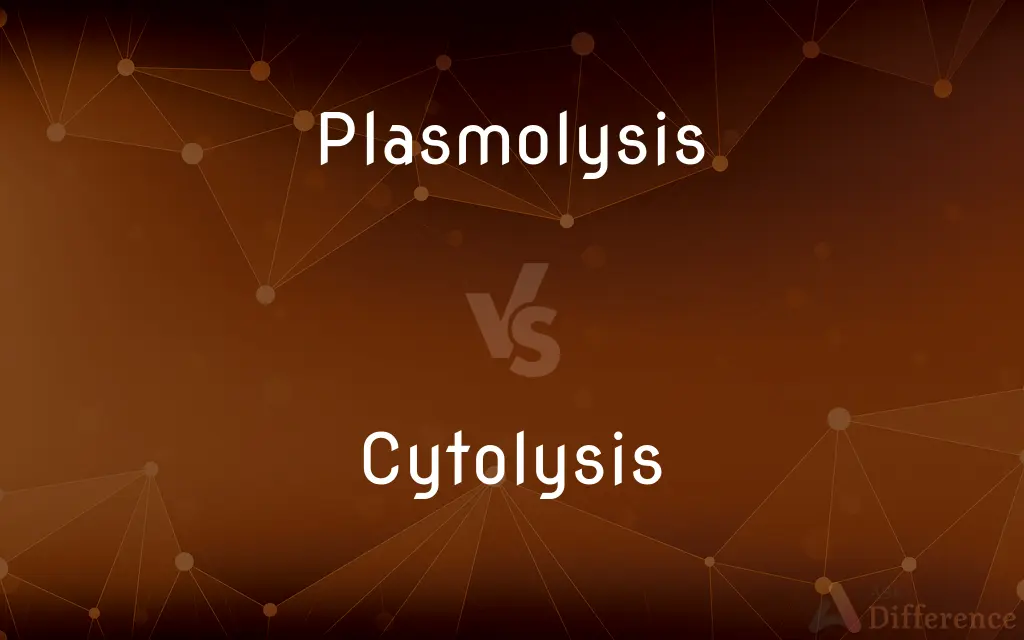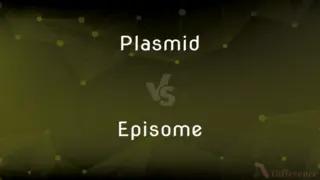Plasmolysis vs. Cytolysis — What's the Difference?
By Tayyaba Rehman — Updated on September 28, 2023
Plasmolysis is the shrinking of the cytoplasm away from the cell wall in plants due to water loss. Cytolysis is the bursting of a cell due to an osmotic imbalance. Both relate to osmotic pressure effects on cells.

Difference Between Plasmolysis and Cytolysis
Table of Contents
ADVERTISEMENT
Key Differences
Plasmolysis and cytolysis are two cellular phenomena that occur as a result of osmotic pressure imbalances. Plasmolysis is primarily associated with plant cells. When a plant cell is placed in a hypertonic solution, it loses water to its surroundings, leading to the contraction of its cytoplasm. This results in the cell membrane pulling away from the cell wall, a process termed plasmolysis.
Cytolysis, on the other hand, is not restricted to plant cells. It occurs when a cell, often an animal cell, is placed in a hypotonic solution. The cell absorbs too much water due to the osmotic gradient, and if the cell cannot manage or expel the excess water quickly enough, it can burst. This rupturing of the cell is known as cytolysis.
While plasmolysis can be considered a protective mechanism for plant cells, allowing them to survive temporary periods of dehydration, it is not without consequences. Prolonged plasmolysis can lead to the death of the cell. Cytolysis, in contrast, is usually fatal to cells since it leads to the immediate rupturing of the cell membrane.
To visually identify these processes, one might observe a wilted plant experiencing plasmolysis. If the plant is watered, its cells will rehydrate, reversing the plasmolysis. In the case of cytolysis, it's commonly observed in laboratory settings where cells are exposed to various solute concentrations.
In summary, both plasmolysis and cytolysis are outcomes of osmotic imbalances. While plasmolysis sees the cell membrane contracting from the cell wall in plants, cytolysis witnesses the bursting of a cell, often in animals.
ADVERTISEMENT
Comparison Chart
Definition
Shrinking of cytoplasm away from the cell wall due to osmosis
Bursting of a cell due to osmotic pressure
Occurs in
Plant cells
Primarily in animal cells
Result of
Hypertonic environments
Hypotonic environments
Outcome
Cell membrane detaches from cell wall
Cell membrane ruptures
Reversibility
Can be reversible if rehydrated
Usually irreversible
Compare with Definitions
Plasmolysis
The contraction of the cell's cytoplasm due to water loss.
When the plant was deprived of water, plasmolysis caused its leaves to wilt.
Cytolysis
The bursting of a cell due to osmotic imbalance.
Placing the animal cell in pure water led to cytolysis.
Plasmolysis
A defense mechanism allowing plant cells to survive dehydration.
Despite the drought, some plants showed plasmolysis, indicating a potential to recover.
Cytolysis
Predominantly observed in animal cells in hypotonic solutions.
The freshwater environment caused cytolysis in the marine cells.
Plasmolysis
A cellular reaction to hypertonic environments in plant cells.
The cell's exposure to saltwater induced plasmolysis.
Cytolysis
Usually a fatal event for the cell.
After cytolysis, the cell components were dispersed in the solution.
Plasmolysis
The detachment of the cell membrane from the cell wall.
Under the microscope, plasmolysis was evident as the cell membrane pulled away from the wall.
Cytolysis
A result of excessive water intake by the cell.
Cytolysis occurred when the cell could not expel the excess water swiftly.
Plasmolysis
Often visible in wilted plants that lack sufficient water.
The gardener recognized plasmolysis in the drooping leaves and immediately watered the plant.
Cytolysis
The rupturing of the cell membrane and release of its contents.
Under osmotic pressure, cytolysis released the cell's contents into the surrounding medium.
Plasmolysis
Plasmolysis is the process in which cells lose water in a hypertonic solution. The reverse process, deplasmolysis or cytolysis, can occur if the cell is in a hypotonic solution resulting in a lower external osmotic pressure and a net flow of water into the cell.
Cytolysis
Cytolysis, or osmotic lysis, occurs when a cell bursts due to an osmotic imbalance that has caused excess water to diffuse into the cell. Water can enter the cell by diffusion through the cell membrane or through selective membrane channels called aquaporins, which greatly facilitate the flow of water.
Plasmolysis
Shrinkage or contraction of the protoplasm away from the wall of a living plant or bacterial cell, caused by loss of water through osmosis.
Cytolysis
The dissolution or destruction of a cell.
Plasmolysis
(biology) the shrinking of protoplasm away from the cell wall of a plant or bacterium due to water loss
Cytolysis
The pathological breakdown of a cell due to the bursting of the cell membrane caused by osmosis
Cytolysis
Pathological breakdown of cells by the destruction of their outer membrane
Common Curiosities
What causes plasmolysis in plant cells?
Plasmolysis is caused by water loss when a plant cell is in a hypertonic environment.
Is cytolysis exclusive to animal cells?
While cytolysis is most common in animal cells, it can occur in any cell exposed to a hypotonic solution.
What visual change suggests cytolysis in cells?
The cell bursts, releasing its internal contents.
Can plasmolysis be reversed?
Yes, rehydrating the plant can often reverse plasmolysis.
Share Your Discovery

Previous Comparison
Discrimination vs. Marginalization
Next Comparison
Plasmid vs. EpisomeAuthor Spotlight
Written by
Tayyaba RehmanTayyaba Rehman is a distinguished writer, currently serving as a primary contributor to askdifference.com. As a researcher in semantics and etymology, Tayyaba's passion for the complexity of languages and their distinctions has found a perfect home on the platform. Tayyaba delves into the intricacies of language, distinguishing between commonly confused words and phrases, thereby providing clarity for readers worldwide.














































